Wednesday, November 17, 2010
New Man vs Old Man
The new man is somewhat of a tyro who wants more but lacks perspective and so has a limited world view. He tends to be more adaptive but suffers from a lack of restraint due to an uncritical nature. Oversimplification leaves him prone to error.
Caesar was a new man who did not respect bounds and ended up with delusions of grandeur. Cicero, also a new man, recognized the need for moderation and balance. He was a rare breed who tried to see both sides but was not fully accepted by either side.
The Renaisance saw a re-emergence of the new man and the beginnings of the Reformation. The spirit of self-determination gained ascendency in northern Europe. In America too there was a break brought about by its treatment as a protectorate by a remote government. America was the New World and its people sought a new beginning. The Enlightenment with its progressive viewpoint had spurred change but the excesses of the French Revolution and the rise of Napoleon raised a lot of doubts.
Perhaps the best approach is that of the "regenerative receiver". He too is no longer satisfied with predetermined solutions and seeks a better picture by reworking the problem. In the process he acquires some knowledge of what is missing. Additional creativity allows one to go beyond what has already been accomplished. A broader perspective takes one beyond the here and now. But the wise man is also interested in bounds.
Jefferson on Education
To George Wythe (Paris, Aug 13, 1786): "...I think by far the most important bill in our whole code is that of the diffusion of knowledge among the people. No other sure foundation can be divised for the preservation of freedom, and happiness."
Report of the Commissioners for the University of Virginia (Aug 4, 1818),
"...The objects of this primary education determine its character and limits. These objects would be,
To enable him to calculate for himself, and to express and preserve his ideas, his contracts and accounts in writing,
To improve, by reading, his morals and faculties;
To understand his duties to his neighbors and country, and to discharge with competence the functions confided to him by either;
To know his rights; to exercise with order and justice those he retains; to choose with discretion the fiduciary of those he delegates; and to notice their conduct with diligence, with candor, and judgment;
And in general, to observe with intelligence and faithfulness all the social relations under which he shall be placed."
"...Some good men, and even of respectable information, consider the learned sciences as useless acquirement; some think that they do not better the condition of man; and others that education, like private and individual concerns, should be left to private individual effort; not reflecting that an establishment embracing all the sciences which may be useful and even necessary in the various vocations of life, with the buildings and apparatus belonging to each, are far beyound the reach of individual means, and must either derive existence from public patronage, or not exist at all. This would leave us then without those callings which depend on education, or send us to other countries to seek the instruction they require. But the Commissioners are happy in considering the statute under which they are assembled as proof that the Legislature is far from the abandonment of objects so interesting. They are sensible that the advantages of well-directed education, moral, political and economical, are truly above all estimate. Education generates habits of application, of order, and the love of virtue; and controls, by the force of habit, any innate obliquities in our moral organization. We should be far, too, from the discouraging persuasion that man is fixed, by the law of his nature, at a given point; that his improvement is a chimera, and the hope delusive of rendering ourselves wiser, happier or better than our forefathers were. As well might it be urged that the wild and uncultivated tree, hitherto yielding sour and bitter fruit only, can never be made to yield better; yet we know that the grafting art implants a new tree on the savage stock, producing what is most estimable both in kind and degree. Education, in like manner, engraphs a new man on the native stock, and improves what in his nature was vicious and perverse into qualities of virtue and social worth. And it cannot be but that each generation succeeding to the knowledge acquired by all those who preceeded it, adding to it their own acquisitions and discoveries, and handing the mass down for successive and constant accumulation, must advance the knowledge and well-being of mankind, not infinitely, as some have said, but indefinitely, and to a term which no one can fix and forsee. Indeed, we need look back half a century, to times which many now living remember well, and see the wonderful advances in the sciences and arts which have been made within that period. Some of these have rendered the elements themselves subservient to the purposes of man, have harnessed them to the yoke of his labors, and effected the great blessings of moderating his own, of accomplishing what was beyond his feeble force, and extending the comforts of life to a much enlarged circle, to those who had before known its necessaries only. That these are not the vain dreams of sanguine hope, we have before our eyes real and living examples."
Jefferson's Esteem for Classical Literature
"...I advise you to begin a course of antient history, reading everything in the original and not in translations. First read Goldsmith's history of Greece. This will give you a digested view of that field. Then take up antient history in the detail, reading the following books in the following order. Herodotus. Thucydides. Xenophontis hellenica. Xenophontis Anabasis. Quintus Curtius. Justin. This shall form the first stage of your historical reading, and is all I need mention to you now. The next will be of Roman history. From that we will come down to Modern history. In Greek and Latin poetry, you have read or will read at school Virgil, Terence, Horace, Anacreon, Theocritus, Homer. Read also Milton's paradise lost, Ossian, Pope's works, Swift's works in order to form your style in your own language. In morality read Epictetus, Xenophontis memorabilia, Plato's Socratic dialogues, Cicero's philosophies..." -The Portable Thomas Jefferson
Tuesday, November 16, 2010
Adams, Jefferson and Coke
Thomas Jefferson also appears to have been familiar with Coke. In a letter to John Page dated December 25, 1762, he writes,
"However, whatever misfortunes may attend the picture or lover, my hearty prayers shall be, that all the health and happiness which Heaven can send may be the protion of the original, and that so much goodness may ever meet with what may be the most agreeable in this world, as I am sure it must be in the next. And now, although the picture be defaced, there is so lively an image of her imprinted in my mind, that I shall think of her too often, I fear, for my peace of mind; and too often, I am sure, to get through old Coke this winter; for God knows I have not seen him since I packed him up in my trunk in Williamsburg. Well, Page, I do wish the Devil had old Coke, for I am sure I never was so tired of an old dull scoundrel in my life...But the old fellows say we must read to gain knowledge, and gain knowledge to make us happy and admired. Mere jargon!"
Thursday, October 21, 2010
Independence of the Judicary Timeline
1776 US Declaration of Independence: grievences
1773 John Adams, Works vol 3, p 522: during good behavior & quamdiu se bene gesserint*
1701 Act of Settlement: quamdiu se bene gesserint, patent for judges
1641 House of Lords petition: quamdiu se bene gesserint
1600 General Assembly of the Kirk of Scotland: ad vitam or ad culpam**
1465 De Officiis first printed
44BC Cicero writes De Officiis. Book II, i, contains quam diu and a form of gerere (to conduct)
* so long as they shall conduct themselves well. Note that gesserint is future perfect indicative. The future perfect is used in Latin conditional clauses.
** for life or until fault (see end of 1st session)
Some Selections from Cicero's De Officiis (On Duties)
Let me now, as I propossed, speak of beneficence and liberality, virtues that are the most agreeable to the nature of man, but which involve many precautionary considerations. For, in the first place, we are to take care lest our kindness should hurt both those whom it is meant to assist, and others. In the next place, it ought not to exceed our abilities; and it ought to be rendered to each in proportion to his worth. This is the fundamental standard of justice to which all these things should be referred. For they who do kindnesses which prove of disservice to the person they pretend to oblige, should not be esteemed beneficent nor generous, but injurious sycophants. And they who injure one party in order to be liberal to another, are guilty of the same dishonesty as if they should appropriate to themselves what belongs to another. (Offices I, xiv, p. 25)
Administration of government:
All who hope to rise in a state ought strictly to observe two rules of Plato. The first is, that they so keep in view the advantage of their fellow-citizens as to have reference to it in whatever they do, regardless of their individual interest. The second is, that their cares be applied to the whole of the state, lest while they are cherishing one part they abandon the others. For the adminsitration of government, like a guardianship, ought to be directed to the good of those who confer, and not of those who receive the trust. Now, they who consult the interests of one part of a community and neglect another, introduce into the state the greatest of all evils, sedition and discord. (Offices, I, xxv, p.44)
Magistrates:
Neither is it foreign to my purpose to touch upon the duties of magistrates, of private citizens, and of strangers. It is then the peculiar duty of a magistrate to bear in mind that he represents the state, and that he ought, therefore, to maintain its dignity and glory, to preserve its constitution, to act by its laws, and to remember that these things are committed to his fidelity. (Offices, I, xxxiv, p. 61)
Knowledge and protecting rights:
...For the knowledge and contemplation of nature is in a manner lame and unfinished, if it is followed by no activity; now activity is most perspicuous when it is exerted in protecting the rights of mankind.
It therefore has reference to the social interests of the human race, and is for that reason preferable to knowledge; and this every virtuous man maintains and exhibits in practice. For who is so eager in pursuing and examining the nature of things, that if, while he is handling and contemplating the noblest objects of knowledge, the peril and crisis of his country is made known to him, and that it is in his power to assist and relieve her, whould not intantly abandon and fling from him all those studies, even though he would be enabled to number the stars, or measure the dimensions of the world? And he would to the same were the safety of a friend or a parent concerned or endangered. From this consideration I infer, that the duties of justice are preferable to the studies and duties of knowledge, relating as they do to the interests of the human race, to which no anterior consideration ought to exist in the mind of man. (Offices I, xliii, p. 72)
Discourse versus thought:
Nor do those philosophers only instruct and educate those who are desirous of learning while alive and present among us; but they continue to do the same after death, by the monuments of their learning; for they neglect no point that relates to the constitution, the manners and the morals of their country; so that it appears as if they had dedicated all thir leisure to our advantage. Thus while they are themselves devoted to the studies of learning and wisdom, they make their understanding and their skill chiefly available to the service of mankind. It is therefore more serviceable to the public for a man to discourse copiously, provided it is to the purpose, than for a man to think ever so accurately without the power of expression; the reason is, because thought terminates in itself alone, but discourse affects those with whom we are connected in a community.
...Every duty therefore that operates of the good of human community and society, is preferable to that duty which is limited to speculation and knowledge. (Offices I, xliv, pp. 75-6)
Sunday, October 17, 2010
Plato and Cicero
Cicero's De Officiis which discusses ones moral duty in serving society is good reading. Cicero had an inclination for philosophy and studied in Athens. The book is addressed to his son. Marcus Aurelius and others have done similar works. De Officiis was the second book to appear in print. It later served as a primary introduction to Latin. James Madison, who studied at Princeton, probably read him as part of his course of study. Thomas Jefferson had several works by Cicero in his library which were later donated to the Congressional Library. Much of what Cicero says is still relavent today.
Both Plato and Cicero wrote works discussing the republic. Much of Cicero's De Re Publica was concealed as a palimpsest until 1822 so it was not available at the time of the US Constitutional Convention.
Wednesday, September 22, 2010
Impressions vs Forms
The ancient Greek philosophers assigned a greater reality to the forms than our perceptions of them. The problem is similar to that of doing fits with the patterns being somewhat imperfect. But the same pattern may be applicable to a number of similar objects (in our case diodes) with different coefficients in the characteristic equations.
In The Sophist Plato uses an "Eleatic Stranger" with extraordinary skill to try to capture what we mean by a sophist. The Stranger first uses the dialect method in an attempt to pin down the sophist but he proves to be an elusive quarry. He appears to be many things at once. After studying "being" and "not-being" and what we mean by these terms he comes to the conclusion that the sophist is a pretender. He does not possess or impart true knowledge. The dialectic is a process of defining a pair of cases to which the object in question either belongs or does not in order to specify what it is. The Stranger looks down on the Sophist and is cutting him at the same time. The Sophist does not rank with the Philosopher.
The case is not quite so bad with the fits but one still can't trust them completely. Theory might help narrow down equations to be fitted but measurements usually have errors associated with them and can produce unavoidable residuals as a result.
Saturday, September 18, 2010
5.1 V Zener Diode Conductance and Estimated Error in Voltages

This conductance can be used to estimate the errors in the voltage measurements and compute corrections. The formula is ΔV = ΔI/G. The results for the steep part of the V-I characterists is shown below. This shows that even though the residuals are relatively large the corrections to the voltage needed to place the points on the curve are within about 1/2 the precision of the measurements and appear to be just round off errors.

The residuals for these points were more randomly distributed. The "corrections" for lower voltages were larger where the curve was flatter and where the fit appeared to deviate somewhat from the data. The conclusion is that relatively larger residuals are to be expected where the slope of the curve is relatively steep.
*edit: This is not the usual conductance which is defined in terms of Ohm's Law, G = I/V. My terminology is somewhat lax. A more appropriate expression might be "small signal conductance" or "differential conductance."
Thursday, September 16, 2010
Does Least Squares Make the Best Choice for Coefficients?
For the fits of the data for the Zener diode I used Mathcad's genfit function. For the composite functions of the last fit the individual fits can also be done by fitting lines in a log-log plot*. One of the problems that I encountered in doing the fits is that the fitted function tended to cut corners in the region of the "knee" where the characteristics change from lower currents to higher ones. As a result there is a correlation among neighboring residuals there. Intuitively one would expect that the residuals would be randomly distributed with respect to the fitted curve for the best fit. There seemed to be something wrong with the residuals.
I decided to give the rms residual more control in doing the fit. I tried dividing the data into sections with each section being represented by a term in the fit function. The result is that the residuals differed for each region. This method also seemed somewhat arbitrary since the terms for the function depended on how the data was partitioned. The results suggested the use of a Taylor series for the current involving exponential functions. Fitting a quadratic function of the first fit didn't work. The difference between the fit for lower currents and the data looked closer to an exponential function that was fairly linear for lower currents so I tried multiplying the current by a factor involving an exponential term. That worked much better than the Taylor series. Varying the number of data points included in the first fit optimized the final fit. The rms residual was closer to the result of a tedious process involving a search for the coefficients in a region of fixed size and a random choice from among a few of the lowest values of the sum of the squares of the residuals to avoid getting "stuck in a loop." (The results of the second fit method weren't consistent. The coefficients posted were the best values found.)
The results show the utility of the residuals in analyzing the results of a fit and comparing one fit method with another.
The economists like to use linear models for optimization problems but nonlinear models may prove to be more useful. Fits can be used to find approximate functions for observable relations in a theory. Doing what is best for the individual is not necessisarily at odds with doing what is best for the group. The problem may be similar to that of finding the best fit for a set of data.
*edit: One would have to do a semi-log plot. For the first fit involving the lower curve one would also have to ignore the small constant, u_0, and plot log(I1/mA) vs V. For the second plot it would be log(I2/I1 - 1) vs I1 (I2>I1) with I1 being the current in the first fit and I2 that of the second fit.
Impossible Choices
If the choice is left solely to individuals though some people can end up benefiting at the expense of others. The most powerful factions end up being self-serving and disregard the interests of others.
Arrow also points out that capital is not the only way to improve productivity. Technological innovation can substitute for capital. This includes the arrangement of the workplace. Improved economy has its benefits. There are other ways of improving. One is education which improves the value of workers. And an economic slowdown may indicate that there are forces at work which tend to obstruct progress.
Monday, September 13, 2010
The Problems With Fitting Zener Diode Characteristics
The fit above consisted of two fits, the first for current of the lower part of the curve and a second fit to determing the diode current as a function of the first current. Both curves are easy to fit. The rms residual is still large compared to the precision of the measurements which was 0.01 mA for the current and the 0.01 volts for the voltage. In the plot of the residuals below one sees large deviations at the higher currents. The relative deviations (residual/current) are of the same magnitude for all currents

The current being a function of a current is consistent with a controlled breakdown. There is also a certain amount of noise present and the current fluctuates some due to a statistical component. The largest contribution to the rms deviation is from the upper portion of the curve.
Supplemental: The correlation among neighbouring residuals near I = 0 mA indicates that the fitted functions are not quite right but this error is small compared to larger residuals which may have contributed to errors in the values of u and v.
Saturday, September 11, 2010
A Better Fit for the 5.1 V Zener Diode

Tuesday, September 7, 2010
RadioShack 5.1 V Zener Diode V-I Characteristics

Thursday, September 2, 2010
NIO Sets His Sights the Moon

Tuesday, August 31, 2010
NIO's Observer Function
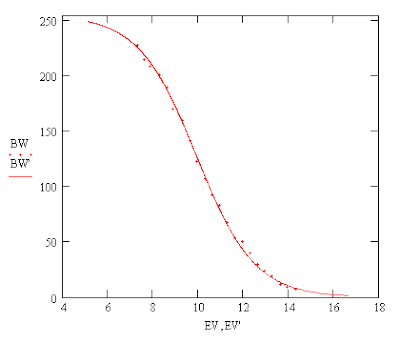
Sunday, August 29, 2010
NIO Does a Little Stargazing.

The stars were brightened relative to the background using a power law with the power, p, equal to 1.6. You may have to click to enlarge the photo to its original size.
The Effect of a Diffuser in Front of the LED
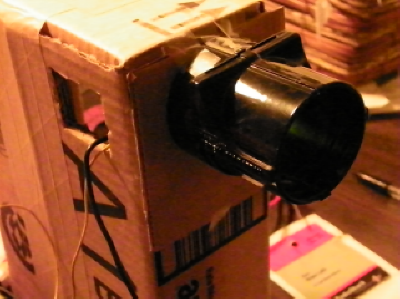
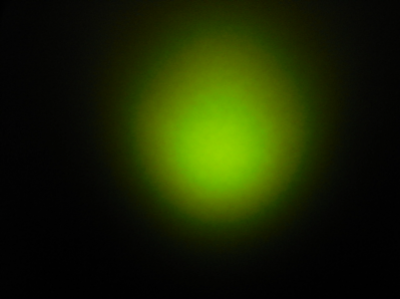
The LED's Luminous Emittance
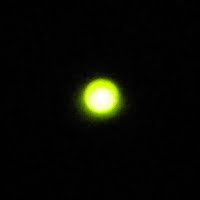
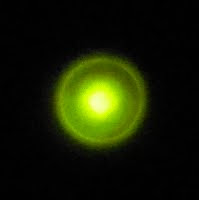
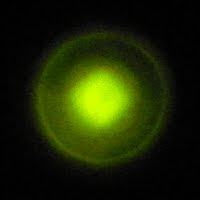
There seems to be a "halo" which surrounds the brighter center of the pattern and grows linearly with distance.
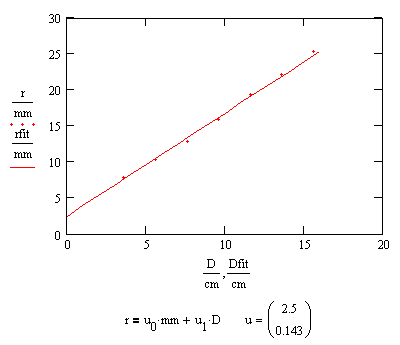
The edge of the halo marks a cone which bounds the emitted light. The angle between the lines common to a plane cutting the light cone in half and the light cone is 18°. At larger distances the central pad where the whisker makes contact interferes with a uniform distribution of light.
Saturday, August 28, 2010
A Standard Candle?
Friday, August 27, 2010
Summary of the Characteristics for the RadioShack 5mm Green LED
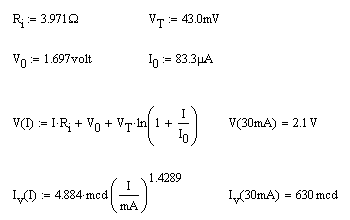
A Peek Inside the LED

Thursday, August 26, 2010
Relative Luminance vs Current
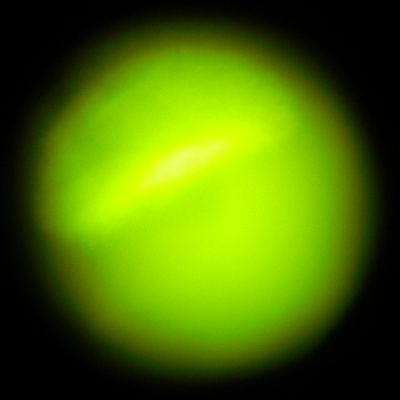
Wednesday, August 25, 2010
The Green LED's Spectrum

New Observer Onboard
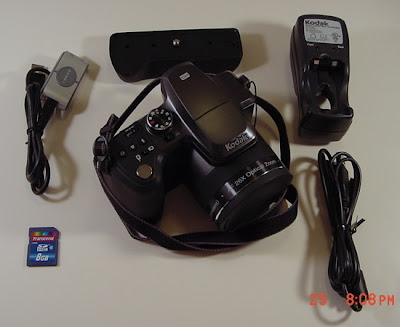
Tuesday, August 24, 2010
Equivalent Circuit for an LED
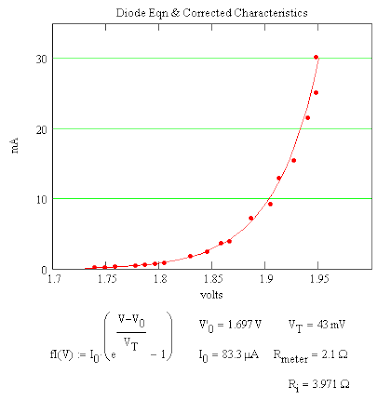
The results suggest the following equivalent circuit for a real diode. There appears to be an interval voltage source, V0, an ideal diode characterized by I0 and the thermal voltage and an internal resistance.
Monday, August 23, 2010
Comparison of the LED Characteristics With the Diode Eqn

I do not know why V0 is needed. It could be that light produces a contact electrification of the junction in the LED.
Sunday, August 22, 2010
Measuring the Characteristic Curve for an LED
While waiting for the repairs to be done I picked up some LEDs at RadioShack. There wasn't much information on the LEDs except forward voltage 2.1 V, current 30 mA, luminous intensity 630 mcd, and wavelength 565 nm. So I tried to measure the characteristic curve using two 1.5 V AA batteries, a resistance box and a digital multimeter to measure the current but the curves proved to be useless even though I corrected for the voltage drop across the resistance box. I decided to get a second digital multimeter and this time measured both the voltage across and current through the LED. The results were better.

Limits of Detectability
One encounters similar problems with human perception. For the eye the limit is the dark adaption threshold. At low light levels an image becomes pointilistic and scintillating. The eye is not equally sensitive to all colors of the same intensity and this is the subject of colorimetry.
Friday, August 20, 2010
Recommended Reading
Petroleum in the Marine Environment: UV Fluroescence Spectrometry
Laser Experiments for Beginners by Richard N. Zare
What Would a Critical Analysis of the Oil Spill Require?
Rep. Markey asked for a formula used in the oil budget calculator. Fluorescence spectroscopy which was used to measure the concentration of the oil near the well falls under the domain of Quantum Electrodynamics. To determine the transition rates one needs to know the oscillator strength function which is related to the Einstein coefficients. One might be able to adjust the spectroscopy data by subtracting the distribution for Rayleigh scattering to arrive at a better estimate. A study of Raman scattering might confirm results. The analysis requires expert knowledge.
Thursday, August 19, 2010
The Scattering of Light by Small Particles
An interesting effect is that of critical opalescence which can be seen in this YouTube video.
Gulf Oil Spill & Seafood Safety Committee Hearing
The seafood sampled were deemed to be safe for human consumption. The main concern was the presence of polycyclic aromatic hydrocarbons (PAHs). The Oil Budget referred to during the hearings indicates what happened to the spilled oil (summary). A more technical report discusses the Oil Budget Calculator about which Rep. Markey asked for more detail on the formulas used. These reports on which the discussion is based are part of a ongoing process conducted by a collaboration, the Joint Analysis Group and the conclusions are not yet final.
Saturday, August 14, 2010
Can We improve on the Digital Color Camera?

Friday, August 13, 2010
Using Exposures Instead of RGB Values
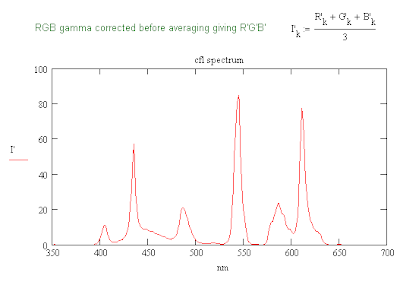 This plot suggests that the color temperature might be higher than data sheet indicated. It is similar to that of the "narrow band" illuminants F10-12 and seems to lie between F12 and F11. The bulb used was not exactly the same as those listed in the datasheet.
This plot suggests that the color temperature might be higher than data sheet indicated. It is similar to that of the "narrow band" illuminants F10-12 and seems to lie between F12 and F11. The bulb used was not exactly the same as those listed in the datasheet.Thursday, August 12, 2010
CFL Spectrum with Gamma Correction
The plot above is for the same CFL spectrum found previously but with a gamma correction applied to the vertical scale. The relative heights of the peaks are probably dependent on the formula for converting the RGB values to a B&W value. The function that my computer uses to convert a color image to B&W shows a stronger response to the G values which one would expect since the eye is most sensitive to 555 nm. I probably need to look for a better conversion formula.
edit: The eye's response to light of different wavelengths is measured by the luminosity function. The RGB values are determined by the color matching functions. All four depend on the illuminant since the spectral power density is a function of wavelength. The conversion formula used may assume a standard illuminant.
Improving on the Accuracy of Your Spectrometer
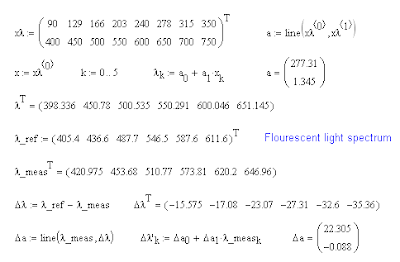
The errors in the positions of the lines ranged from about -15 nm to -35 nm depending on the value of the measured wavelength.
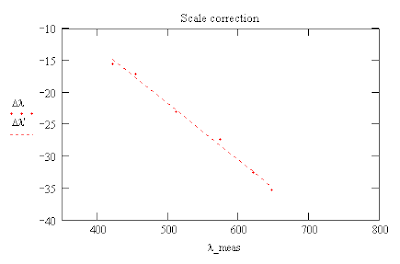
One can then use these formulas to calculate a corrected scale for the wavelengths of the mercury spectrum.
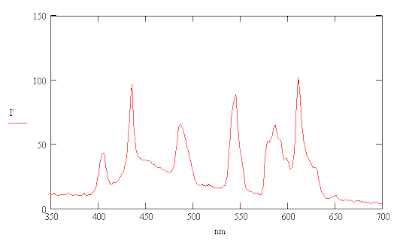
Tuesday, August 10, 2010
Adding Violet to the Spectrum
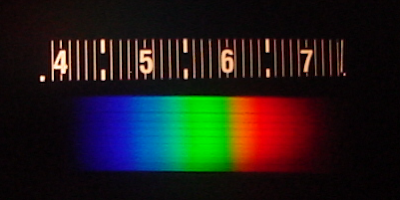
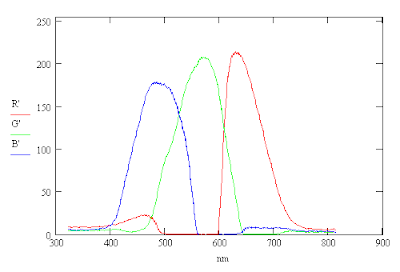
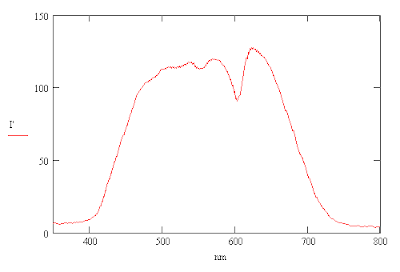
The reason appears to be that the camera is not sensitive enough to red light below a wavelength of 500 nm. Each pixel of an RGB image has values of R, G and B ranging between 0 and 255 for the colors red, green and blue respectively. One can add a synthetic violet to the image by replacing the R value by 4R if the B value is greate than the R value but only to those portions of the image that you want to correct. This effectively makes the R image more sensitive to violet light. The changes are shown below.
Friday, August 6, 2010
Two Steiner Problem and Soap Film Solution References
Initial Results on the Diffusion Experiment

I checked the Petrie dish some time later and the spots of dye showed a noticable amount of diffusion. So I made my first observation which was the image above. I cropped the original 1600 x 1200 image to obtain to get a 150 x 150 image of the lower right spot.
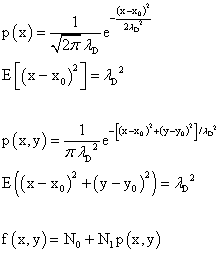
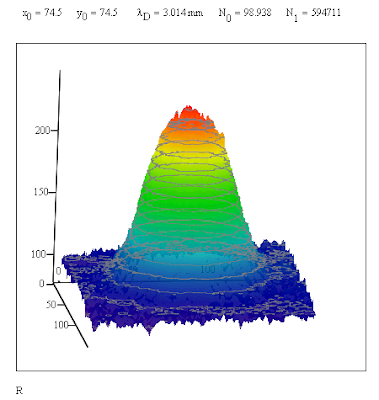
edit: There was a typo in the expression for the expected value of the one dimensional diffusion case. I had initially used λ squared as the divisor in the exponent of the Gaussian function. It's now been fixed. One could call the standard deviation the "deviation length."
Wednesday, August 4, 2010
Sony DSC S50 Response for Normal Exposure
Note that the RGB response curves are clipped near the peaks giving a flatter response.

The result is that the intensity has two peaks in it corresponding to yellow and cyan which are brighter by nature. The colors red, green and blue are the corners of the color cube which are closer to black while yellow, cyan and magenta are corners closer to white and hence brighter. Physically the energy density at each wavelength in incandescent light is about the same for thermal radiation at 3000 °K and one would expect a similar response at all frequencies. The eye is most sensitive to green and one would expect a stronger response there.
The conclusion is that the camera does not respond in the same way to light that is underexposed as it does to a normal exposure. The colors in shadows may be shifted somewhat. One does not see the colors yellow or cyan in the underexposed spectrum. The underexposed images give a better indication on how the RGB filters work.
edit: Photopsins are the protein-pigment complexes which determine the human eye's response to light.
Tuesday, August 3, 2010
Sony DSC-50 Spectral Response to Incandescent Light

The camera setting were 1600x1200, autofocus, spot metering and EV -2.0 (bias) for which the camera selected f/4.0 at 1/60 sec. Averging the RGB pixel values vertically along the spectrum gave the following response curves from the red, green and blue images. The averaging helps smooth the curves.
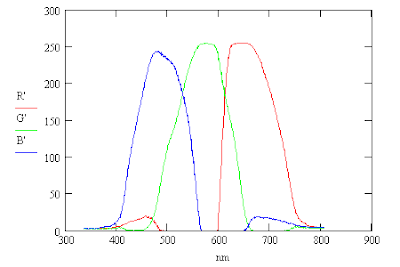
These RGB curves can be used to compute the corresponding intensity curve, I.

One can compute the intensity, I, from the RGB averages by using the following formula. The formula gives the same curve that one gets by converting the color image into a black and white image. Division by 3 is needed so that the intensity of white, R=255, G=255, B=255, is also equal to 255.

The light produced by an incandescent light bulb is primarily thermal radiation produced by a heated filament. The color temperature of the light is about 3000 °K and so it has more red light present than blue light. This may be why the red peak is higher than that of blue.












